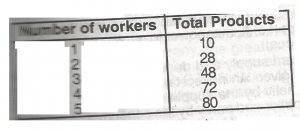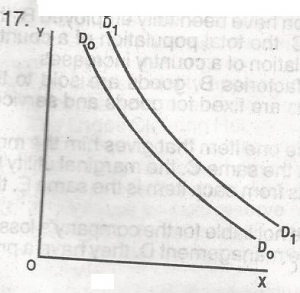
Study the table above: What is the marginal product of the second worker?
- A. 10
- B. 20
- C. 15
- D. 18
- E. 43

The quantity supplied of a commodity increases while
- A. production incraases
- B. demand increses
- C. price of the commodity increases
- D. population of the country increases
- E. more commodites are imported
Infant industries are
- A. a baby food and a baby clothing factories
- B. those which are introducing new products
- C. cases of arrested development
- D. industries temporarily protected by tariff barriers until mature enough to compete on world markets
- E. industries that are allowed to remain permanent cases of adolescence
In most cases the marginal utility derived from a particular good
- A. increases as additional units are consumed
- B. increases at a decreasing rate as additional units are consumed
- C. decreases at a constant rate as additional units are consumed
- D. decreases as additional units are consumed
- E. remains constant as additional units are consumed
Inflation can be curbed by
- A. increasing aggregate demand
- B. paying higher wages
- C. increasing government expenditure
- D. reducing aggregate demand
- E. a deficit budget
The pre-dominance of non-working housewives and maids in West Africa
- A. will understate the national income of the countries
- B. will overstate the national income of the countries
- C. will lead to constant per capita income over the years
- D. will lead to balance of payment deficits
- E. will cause unfavourable terms of trade
The burden of tax on a commodity whose demand is infinitely inelastic
- A. is zero
- B. will be borne by the seller alone
- C. will be borne by the buyer alone
- D. will be borne by both buyer and seller
- E. is impossible to tell who bears it
A typical corporate form of business organization is owned by
- A. President of a country
- B. Shareholders
- C. The general manager and the executives
- D. A local government
- E. Foreigners and citizens of the country
What do we call a market where there is large number of buyers and sellers, such that no one has an appreciable influence over prices?
- A. Free market
- B. Perfectly competitive market
- C. Controllled market
- D. Stock exchange market
- E. Open market
Disposable income equals
- A. personal income less business profits
- B. personal inome minus taxes and subsidies
- C. national income less borrowing from abroad
- D. national income plus transfer of payments
- E. personal income less taxes plus subsidies
When marginal cost equals marginal revenue of products
- A. the firms is producing at a loss
- B. the firm is at a break-even point
- C. the firm is making the least profit
- D. the supplementary cost of the firm is highest
- E. the firm has maximum profit
The price mechanism
- A. regulates supply and demand
- B. rations the consumers
- C. rewards the producers
- D. allocates scarce resources
- E. does all of the above
Which is the most liquid of the following financial assets held by an individual?
- A. Outstanding balance on the current account of a commercial bank
- B. A credit balance on a savings account
- C. A crossed postal order
- D. An insurance policy
- E. All of the above
The ‘terms of trade’ means
- A. the trade agreement between two countries
- B. the difference in the volumes of exports of two countries
- C. the value of a unit of export in relation to the value of a unit of import
- D. the production of total value of exports to the value of total trade
- E. None of the above
The foreign exchange rate of a country is
- A. the interest rate fixed by the central bank
- B. the price of one national currency in terms of another
- C. the rate at which the central bank issues money
- D. the rate of interest on government bonds
- E. None of the above
An ad valorem tax means
- A. total amount of an income tax
- B. a certain percentage on the value of a commodity
- C. a certain percentage tax on the volume of commodity
- D. a tax on capital gain
- E. a profit tax
which of the financial institutions cannot direct tax loans to individuals?
- A. The agricultural bank
- B. The Industrial bank
- C. The central bank
- D. The Co-operative bank
- E. The Standard bank
Which of the following is not a component of national income at factor cost?
- A. Wages earned by doctor
- B. Rent paid to landlords
- C. Indirect tax
- D. Undistributed company profits
- E. Interest on loan
Which of the following assets of the commercial bank does not yield revenue?
- A. Money in the tills of the bank
- B. money at call
- C. Treasury certificates
- D. Treasury bills
- E. Bills of exchange
Pure monopoly describes market where
- A. there are many sellers and a few buyers
- B. goods are sold at different price
- C. entry is not blocked, but no one cares to enter
- D. a few sellers and one buyer exist
- E. None of the above
If a government is running deficit, this means
- A. A term of trade are unfavourable
- B. more project cannot be undertaken
- C. Tax inflow is greater than expenditure
- D. aggregate demand is greater than aggregate supply
- E. tax inflow is less than expenditure


